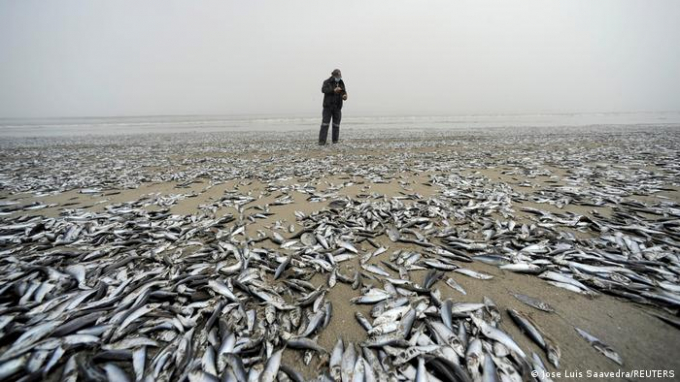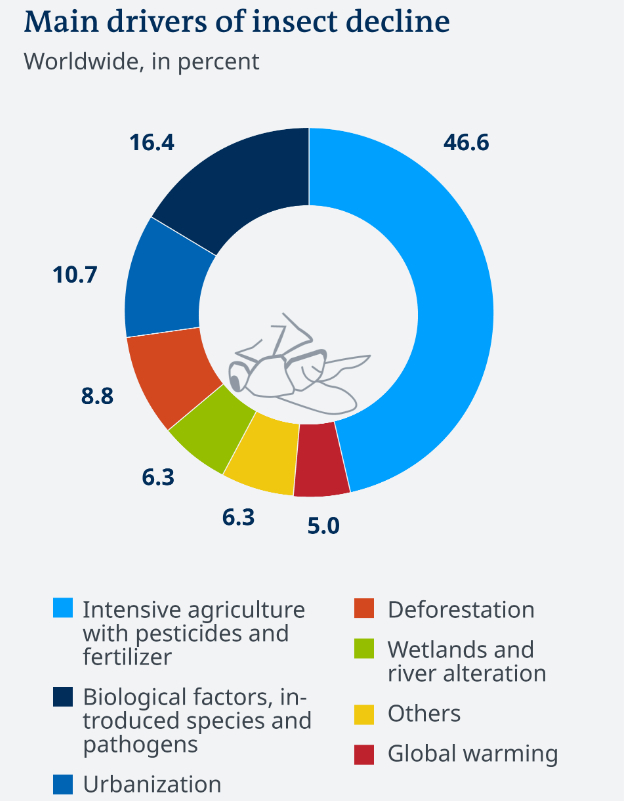May 22, 2025 | 11:11 GMT +7
May 22, 2025 | 11:11 GMT +7
Hotline: 0913.378.918
May 22, 2025 | 11:11 GMT +7
Hotline: 0913.378.918

Like a scene from the apocalypse: massive numbers of dead fish washed up in Horcones, Chile
Mass species extinction is taking place right before our eyes, and yet most of us hardly notice. The dying can't circulate online petitions or stage demonstrations. Often, we don't even know they exist.
Of the estimated 8 million animal, fungi and plant species on our planet, only a fraction have been scientifically documented, according to the international biodiversity council IPBES.
Yet according to scientists, the world may lose nearly 1 million species by 2030, with one species already becoming extinct every 10 minutes. This is catastrophic, because a world that lacks diversity is a dangerous place for all species, including humans.
Later this year, at the second phase of the 15th UN Biodiversity Conference in Montreal, Canada almost 200 countries hope to agree on a new international framework for the protection of biodiversity. The agreement text is being prepared this week in Nairobi, Kenya.
Will the global community succeed in halting the extinction crisis? Here's what you need to know.
A bee flying towards a blue flower
What is biodiversity — and what does it mean to lose it?
A recent report from the Leibniz Research Network for Biodiversity stressed how the great variety of species on our planet's is essential to just about every aspect of human life. "Whether it is the air we breathe, clean drinking water, food or clothing, fuel, building materials or medications — our life, our health, our nutrition and well-being all depend on the great diversity of resources that nature provides us with," it stated.
More than two-thirds of all crops worldwide rely upon natural pollinators such as insects. Without them, our food supply is likely to become less secure. Yet a third of all insect species worldwide are already facing extinction.
Losing biodiversity could also spell disaster for the medical sector, as many pharmaceuticals — including close to 70% of cancer treatments — are derived from nature.
"The knowledge of 3.5 billion years of natural evolution is stored in biological diversity," said Klement Tockner, director of Senckenberg Society for Nature Research, a group based in Frankfurt, Germany. "The progressive decline of our ecological capital poses the greatest threat to all of humanity — because once it's lost, it's lost forever."
What are so many species going extinct?
The answer is human beings. As Earth Overshoot Day illustrates, every year we consume more of our planet's resources than can be replenished.
Industrial agriculture, deforestation, overfishing, pollution, the spread of invasive species and soil sealing to make way for infrastructure are all contributing to an extinction rate that's now 1,000 times higher than it would be without humans around.
Is losing a few species really such a big deal?
Throughout Earth's history, species have lived, thrived and ultimately died out. But never before has so much biodiversity disappeared in such a short space of time. And certainly not due to another species.
According to the German Federal Agency for Civic Education, between 1970 and 2014, the global population of vertebrates declined by 60%, while in South and Central America, that figure is almost 90%. The number of species living in freshwater environments decreased by 83% during the same period.
Johannes Vogel, director of the Berlin Museum of Natural History, said losses within a single genus can have repercussions through the entire ecosystem — including on humans.
"Frogs are currently dying out worldwide because of a fungus spreading due to climate change," he said. "Frogs eat a lot of mosquito larvae for example, so there will be more mosquitoes in the future — and mosquitoes cause more deaths globally than any other organism."
How humans threaten entire ecosystems

Ecosystems are the interaction of different species that depend on one another for survival and their environment.
Healthy ecosystems can withstand a certain amount of damage to an individual part and recover. "But the more we reduce the number of species, the more susceptible a system becomes to disturbance," explained Andrea Perino of the German Center for Integrative Biodiversity Research at the University of Halle-Jena-Leipzig.
The Amazon rainforest, for example, has been reduced so drastically to make way for agriculture and mining that what's left is also less able to regenerate, according to a recent study. It's a dangerous feedback loop that could ultimately lead to this entire ecosystem being lost.
Why is conserving biodiversity so difficult?
As early as 1992, the UN Conference on Environment and Development in Rio de Janeiro adopted the international Convention on Biological Diversity (CBD).
Under the convention, signatory countries committed to promoting sustainable economies that operate within our planet's ecological limits. Further conferences and agreements followed. But so far, hardly any of the aims set out three decades ago have been achieved.
Perino said the problem is all individual nations had to set their own conservation targets, but many of these have amounted to nothing more than declarations of intent. Particularly in industrialized nations, very few effective measures have been implemented.
Tools to assess progress toward CBD targets have also been lacking. "It is often not at all clear whether protective measures are achieving anything at all," Perino said. "We urgently need comprehensive monitoring of any changes."
Why do we talk about the climate more than nature?
"While we can agree to work toward the 1.5 degrees Celsius target on the climate crisis — the fight against the crisis of nature is much more complex,” said Nicola Uhde, biodiversity policy expert at German environmental NGO BUND. "It cannot easily be reduced to a buzzword or standard."
"Awareness of the value of nature often only emerges with its loss," she added.
Unlike floods, droughts or melting glaciers, dying frogs rarely make the headlines. Yet the climate and biodiversity crises are intertwined.
Rising temperatures and changing climatic conditions are driving some species to extinction. And as forests are cleared and wetlands drained, not only do the species they support vanish, essential carbon sinks are also lost, which in turn increases global warming.
This is why both crises need to be tackled together, said Tockner: "Renaturation, such as the rewetting of peatlands, not only helps biodiversity, but also the climate."
What are the sticking points at COP15?
In the preliminary negotiations for the UN Biodiversity Conference coming up in Canada, signatories — now around 200 states — have said they intend to place 30% of global land and sea under protection by 2030.
Perino said this sounds good, but it is unclear what is meant by protection. "After all, there are both strong and weak categories of protection. And nature often finds its way back into balance not through protection, but through renaturation," said Perino.
It's also unclear how this 30% of the surface of the Earth is to be spread between countries. BUND is demanding that each country should apply the rule domestically. "This is important so that all existing ecosystems are covered in the process; that is, not just tundras or the Antarctic, but also tropical rainforests, Central Europe's red beech forests, the mangroves or coral reefs," said Uhde.
Financing protection measures is another sticking point in the negotiations. In the wealthiest countries, very few primary natural habitats have survived industrialization, while many economically weaker countries still have far more biodiversity.
To better protect it, poorer nations are calling for rich countries to increase financial aid for conservation from $160 billion (€152 billion) to $700 billion (€667 billion) by 2030.
(DW)

(VAN) Attempts to bring down the price of the Japanese staple have had little effect amid a cost-of-living crisis.

(VAN) Fourth most important food crop in peril as Latin America and Caribbean suffer from slow-onset climate disaster.

(VAN) Shifting market dynamics and the noise around new legislation has propelled Trouw Nutrition’s research around early life nutrition in poultry. Today, it continues to be a key area of research.

(VAN) India is concerned about its food security and the livelihoods of its farmers if more US food imports are allowed.

(VAN) FAO's Director-General emphasises the need to work together to transform agrifood systems.

(VAN) Europe is facing its worst outbreak of foot-and-mouth since the start of the century.

(VAN) The central authorities, in early April, released a 10-year plan for rural vitalization.